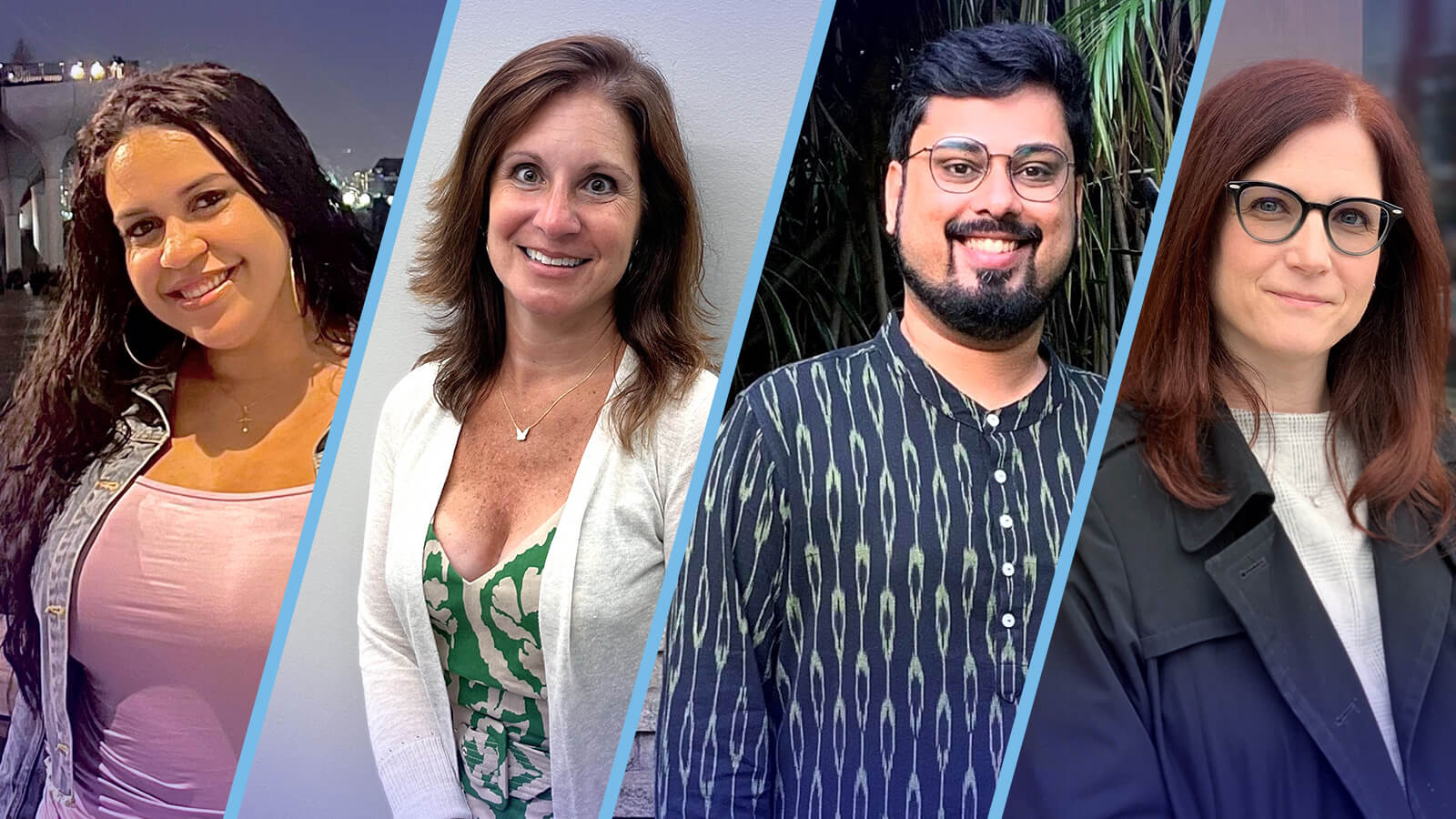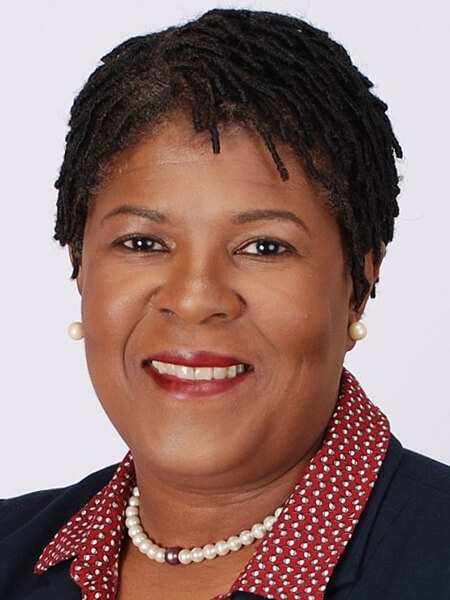
We’ve all heard it before: “Migraine is more than just a headache.” But is it really understood? Some talk about the burden of migraine—the blur of pain, vice-like pressure, nausea, insomnia, and even vertigo—but most don’t.
Migraine is a disabling neurological disease with different symptoms and treatment approaches compared to other headache disorders. An estimated 40 million people in the United States and more than 1 billion people around the world experience migraine attacks.1,2
So, at Pfizer, we’re talking about it—especially this week. Migraine Awareness Week is September 4-13, 2023. To increase that awareness, we’re sharing the impact migraine has on some of our colleagues and the different ways that they cope with attacks. Every person navigates their migraine attack differently, representing the different “personas” they use to manage migraine at work.
The Hydrater
Giselle Salcedo
Administrative Professional, United States

My Migraine
I was diagnosed with migraine about five years ago. At first, I disregarded my symptoms as a simple headache. But as my symptoms progressively worsened, to the point that I was unable to open my eyes, I realized I was dealing with a more complex issue. I sought help, and that’s when I realized I wasn’t dealing with the occasional headache. Instead, I was diagnosed with migraine.
How I Feel & Deal with My Migraine at Work
Each migraine attack comes with a different range of symptoms, which dictate how I cope. I can experience light sensitivity, so the light from my computer can bother me. Sometimes I will turn off the camera on my laptop during a meeting, and when I can, I will take a break to reset and connect with myself. When I have a small migraine attack, I can push through it by constantly drinking water. But that is not always possible; it truly depends on the intensity of the migraine attack.
What I Wish People Knew About Migraine
You truly do not know what I am going through. I can sit in a room and talk to you about budgets; you would never know the suffering behind my mask. We need people to understand the depth and how hard it is to navigate life with this. Once people understand the intensity, and how it affects someone, I believe support and compassion will follow. I want people to understand that I’m going to get it done, but sometimes it may take me longer than usual.
The Endurer
Nora Vainstein, MD
Emerging Markets, Internal Medicine Medical Affairs, Argentina

My Migraine
My symptoms started when I was 13 years old, but my doctor dismissed them. He told me that these symptoms were “just what women have.” Years later, during my medical residency, I called in a neurologist to see one of my patients. He said that I looked like I was in pain. I admitted that I had had a headache for five days, and he offered to see me later. That was when I was diagnosed with migraine.
How I Feel & Deal with My Migraine at Work
Most of my colleagues do not know when I have a migraine attack. And unless I am close to someone, I do not feel comfortable telling them when I am having a migraine attack, so I just try and manage. I mean, I got married while I was experiencing a migraine attack! But sometimes, when I have a really bad attack, I feel like I am living in slow motion, and then I know I must reschedule an event or meeting. I usually try my best to manage and only talk about it if the pain is bad enough to put me in “slow motion,” causes me to be photophobic, and makes it hard to focus.
What I Wish People Knew About Migraine
The reason most of my colleagues don’t know that I have migraine is that I’m afraid that they will think I’m making an excuse. But people need to know it is not an excuse; it is a real disabling disease. And I want to be able to tell people what is going on—not so that they feel pity or so that they move a meeting, but just so they understand why I may not seem like my usual self. And really, all I need is that understanding.
The Take-A-Breaker
Hindol Mukherjee
Global Communications, India

My Migraine
I was diagnosed with migraine nine months ago. The first time I had a migraine attack, I assumed it was a headache because I had started working in a global role with work hours spanning many time zones. I had never experienced anything like it. I never understood how bad migraine attacks were until I got them myself. After getting them regularly, I went to a doctor, who told me I was not having headaches—I was having migraine attacks.
How I Feel & Deal with My Migraine at Work
I experience severe, constant throbbing pain in one side of my head. It feels like someone is hitting my head with a hammer. There are times I get disoriented and cannot focus. For instance, I will be talking to my coworkers and I will not understand what I am saying or what they are saying to me. Then I realize, “Oh, I’m having an attack. I have to take a break. I have to put my health first.” So, I switch everything off, go to a dark space, close my eyes, and try to rest. I say “rest” because I can’t sleep when I have a migraine attack.
What I Wish People Knew About Migraine
People need to understand that it is a really serious issue. It is not a way to slack off or take a day off. It is a disease that has pre- and post-effects on health. I am lucky; my manager works in primary care, so she knows what migraine entails. She has really helped me by encouraging me to take a step back and focus on my health. This is the best way to give support, to put your colleague’s well-being first.
The Explainer
Dr. Nicole Shaffer, DNP, CRNP-BC, COHN-S, FAAOHN
Colleague Wellness, United States

My Migraine
About 13 years ago, I started having headaches on the right side of my head and losing my balance. My story is a bit different because I was treated for breast cancer a year before these symptoms came on. My new issues triggered a worry that my cancer had returned and spread to my brain. So, I underwent extensive testing, and that’s how I learned I had migraine.
How I Feel & Deal with My Migraine at Work
Besides the pain, my migraine attacks come with neurological symptoms. For example, I lose my balance, my hands and toes tingle and go numb, and I get visual disturbances. When I get an attack at work, I tell my colleagues so they understand why I may talk slower or take longer to articulate my thoughts. I also take screen breaks between meetings, closing my eyes to reset so I can keep working.
What I Wish People Knew About Migraine
Even though I can work through most of my migraine attacks, not everyone can. In fact, when I get an intense migraine, I cannot work either, much less lift my head from my pillow. This is not something people use as an excuse; migraine makes people miserable, and it is debilitating. And people need understanding from others. It helps when colleagues say things like, “Please take care of yourself; make sure you’re okay.” This gives people the grace and space they need to feel better. That is why I share my experiences. Because the more we talk about it, it helps others realize they can too.
The Pusher-Througher
Terry Griesing
Chief Medical Affairs Officer, United States

My Migraine
I began having horrible headaches as a teenager. The headaches became progressively worse over time, and when I reached my early twenties, my “headaches” got more intense. I knew I had to see a neurologist, and after a neurological exam and imaging, I was officially diagnosed with migraine. There was limited understanding of migraine in the medical community, and this left me very reluctant to share my experience with my family, friends, and colleagues.
How I Feel & Deal with My Migraine at Work
In addition to the headache, I experience a range of symptoms such as sensitivity to light, loud noise, and strong scents. Most times, I can get through the workday. However, there are some that are so severe or times that I wake during the night or early morning with a piercing pain in my left eye that travels to the base of my skull. These headaches usually progress and also spread to the right side with an intense, pulsating pain. During the severe migraine attacks, I also experience nausea and vomiting, and many times I still feel fatigued and have cognitive “fog” the next day.
What I Wish People Knew About Migraine
I know many people with migraine say, "It's more than a headache." And I totally agree with that. But it's also about quality of life. As a mother, it can be hard enough to balance life and work, but then you add migraine to the equation and it becomes even harder. When I finally began to share that I suffer from migraine, my family, friends, and colleagues were empathetic. But even with such great support, migraine can take an emotional toll, and there are still times that I feel the weight and guilt of missing family or work commitments. My hope is that by sharing my story and experience, more people will understand the physical and emotional impact of migraine and that others suffering in silence become more comfortable talking about their own experience so we can collectively destigmatize this condition.
The Advocator
Heather Derck
Women’s Health, United States

My Migraine
I started getting migraine attacks as a teenager. I called them “bad headaches” and always blamed myself when I got one. For years, I put band-aids on the problem and settled for “doing a little better.” Opening up to others about what I was experiencing was the turning point that led me to finally take control, do my homework, and advocate for myself with my primary physician. And while I still experience migraine attacks, they no longer have the same vise grip on my life that they once had.
How I Feel & Deal with My Migraine at Work
Several years ago, my attacks had become more frequent, intense, and difficult to treat. It’s a relentless piercing and pulsating pain behind my left eye, with nausea, vomiting, and light sensitivity. I was desperate to avoid that pain and lost time. More and more, I found myself planning my life around the possibility of a migraine attack. And when, inevitably, one would arrive, I had no choice but to cancel plans or take time off work so I could retreat to a dark room for at least a day, sometimes longer. My migraine had never been something I talked about, especially at work. But as the attacks became worse, it was hard to hide. One day I was visibly in pain during a meeting and let my colleagues know what was happening. The help and support that they responded with led to a real turning point for me. I realized not only that I needed to talk about it but also that by doing so, I could help create that safe space for others to do the same.
What I Wish People Knew About Migraine
For a long time, I wouldn’t have shared this story. Back then, I didn’t even know it was worth sharing. That's a big part of the problem, isn't it? Minimizing what we are experiencing and letting that hold us back from reaching out for the support and care we need. It’s okay to say you’re not okay—to your loved ones, your colleagues, and, very importantly, your healthcare provider. My hope is that by sharing this, it inspires someone to be an active advocate for themselves or others. Time is too precious to wait!
The Supporter
Caoimhe Graham
Global Marketing, United Kingdom

What I Used to Think of Migraine
I had a good friend in university who had migraine, but no one really understood what that meant. When she would describe her symptoms to us, we figured she was being dramatic—we thought everyone got bad headaches sometimes. We didn’t realize the extent of what she was going through.
My Turning Point
I’ve learned a lot more about migraine in the last year and a half from Pfizer colleagues and other people in my life.
Recently, a group of friends and I planned to get together for brunch. Right beforehand, one of my friends sent a massive apology text explaining that she’d been dealing with a migraine attack for 48 hours and couldn’t make it. I just wrote back saying, “No pressure and no worries, feel better soon—I totally understand.”
She was so shocked! She said it was one of the first times that she didn't have to justify or send a list of symptoms, that “migraine” said it all. In and out of the workplace, I think many migraine sufferers feel a lot of guilt surrounding their migraine and believe they have to justify their symptoms. I want to make sure my colleagues know that they don’t have to feel guilty.
What I Know About Migraine Now
The way we speak to people with migraine can make a big difference. I now understand that it's not about empathizing with their level of pain, because if you don’t have migraine, you can’t. You don’t know what they go through.
People with migraine may not want to go into detail about their condition. So, anything we can do to support our colleagues and take some stress away can help them take the space they need.
By educating colleagues, we can show people with migraine that they don't need to justify or explain how they're feeling. I think this will help empower colleagues to feel more comfortable opening up, even if it's just to their manager or a friend on the team.
The Compassionate Coworker
Ann-Marie Richard, PhD
Patient Engagement, United States

What I Used to Think of Migraine
When I was growing up, there was a classmate in my high school who always missed tests because she said she had migraine. She was ridiculed and labeled as lazy. And, I have to say, I also thought she was making excuses because she did not want to study.
My Turning Point
We held a migraine patient panel at work recently. I heard personal stories and listened to the details of how those with migraine have suffered. I realized how debilitating it can be. One of the participants revealed that at the peak of her migraine attacks, when she could not get rid of them, she considered self-harm. I was in tears. I realized that my childhood friend was likely genuinely in pain—physically and emotionally—from migraine.
What I Know About Migraine Now
Migraine will only be destigmatized once people are aware of how it impacts people's day-to-day lives. There is no better way to educate than through the experiences of others. You can read it from a textbook or hear it from a physician, but when you hear about it from a person living with it day after day, that is the most significant learning. It personalizes the experience. Plus, when people with migraine hear others talk about their experience, it can resonate and empower them to share theirs too.
By listening and learning from patients, as well as care partners, I get a better understanding of patients’ experiences with serious diseases like migraine. This allows me to better support my coworkers who are living with these same diseases but might not feel empowered to express how they feel, especially at work. I currently have a close colleague who experiences migraine and now I encourage her to take the time she needs to recover.
How You Can Help
Did you recognize yourself or someone you know in these persona stories?
Are you wondering how you can be a Supporter like Caoimhe or a Compassionate Coworker like Ann-Marie? When a friend or coworker tells you they have migraine, bear in mind that they may be nervous about your perception. So, really listen and encourage them to tell their story. Acknowledge the courage it takes to open up.
Or do you have migraine and identify with one of the other personas? First and foremost, take care of yourself! And take some comfort in knowing that you’re not alone. Put your faith in a trusted coworker, friend, or family member and open up about your experience.
The more we talk about migraine, the better we can support everyone who lives with it.
References
- GBD 2017 Disease and Injury Incidence and Prevalence Collaborators. Lancet. 2018;392:1789-1858.
- Buse et al. Burden of Illness Among People with Migraine and ≥ 4 Monthly Headache Days While Using Acute and/or Preventive Prescription Medications for Migraine. Journal of Managed Care & Specialty Pharmacy. 2020;26(10):1334-1343.
04.21.2025
04.17.2025
04.16.2025
04.09.2025
04.01.2025
